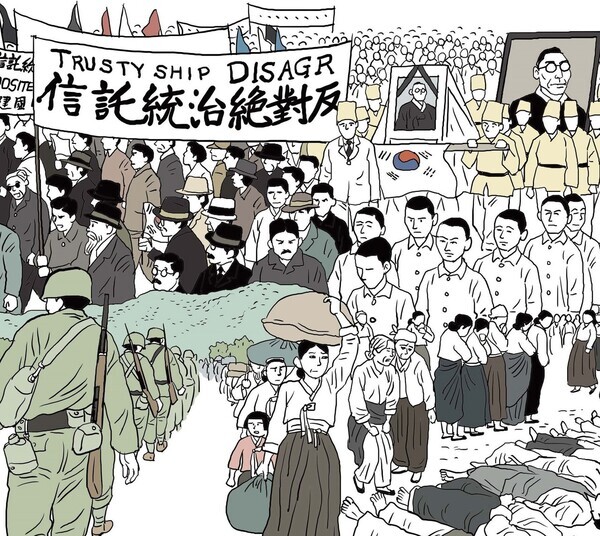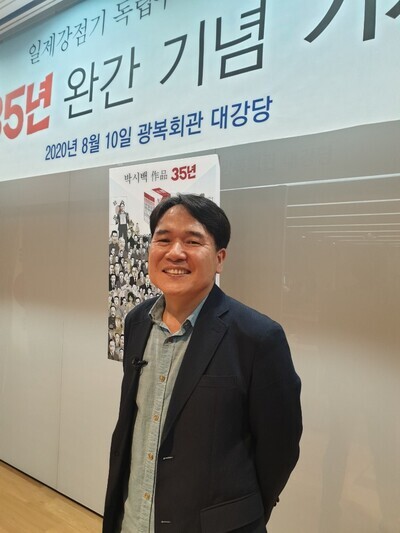hankyoreh
Links to other country sites 다른 나라 사이트 링크
[Interview] S. Korean cartoonist finishes 7-volume series on independence movement

"Considering that the comfort women for the Japanese army remain a major issue today, I’ve regarded the history of Japan’s colonial occupation of Korea as being not only part of the past but also tied to the present,” said Park Si-baek, a 56-year-old South Korean cartoonist. Park was speaking on the afternoon of Aug. 10 during a press conference that marked the completion of his comic book series “35 Years.”
“I started drawing the ‘35 Years’ series with a sense of mission: to summarize the history of that era for readers while bringing to their attention both little-known independence activists and the collaborators who stood with Japan, on the opposing side,” Park said.

Over the past three years, Park drew “35 Years,” published by Via Books, a historical comic series dealing with the Japanese colonial occupation. He’d spent the previous decade working on a 20-volume series based on the “Veritable Records of the Joseon Dynasty,” which he wrapped up in 2015.
“35 Years” depicts Japan’s oppressive colonial occupation and the independence movement’s opposition to that occupation from Aug. 29, 1910, when Japan forcibly annexed Korea, to Aug. 15, 1945, when Korea was liberated by the Allies. The first three volumes were published in January 2018 and the fourth and fifth in May 2019, while the sixth and seventh are slated for release on Aug. 15, Korea’s Liberation Day. The seven volumes run for 2,140 pages and feature 1,000 people.
Colonial occupation is a history of humiliation but also something we should be proud of“The 35 years of Japanese colonial occupation are not merely a history of humiliation, but also a history in which we can take pride. Those years are the history of our struggle against Japan, a fierce struggle waged by our ancestors,” Park said during the press conference, which was held at Liberation Hall in Yeongdeungpo, Seoul.
A sneak peak of “35 Years” appears in the final volume of Park’s illustrated version of the “Veritable Records of the Joseon Dynasty,” the volume about the fall of the Korean Empire, as the dynasty was known in its final days. The volume ends with a scene depicting the faces of key members of the independence movement, including Kim Koo, An Jung-geun, and Ryu Gwan-sun. “Joining the independence struggle meant facing cold and hunger, torture and imprisonment, and firing squads and the gallows, as well as suffering and penury for one’s family members. We are here today because our ancestors were willing to suffer those things and were not afraid to fade, nameless, from the pages of history,” Park wrote.
Park admitted that he’d felt even more pressure about drawing “35 Years” than with his previous work. “I didn’t feel much stress about ‘Veritable Records of the Joseon Dynasty’ because I had a definite text to work with and just had to remain faithful to that. But with the Japanese colonial period, I wasn’t sure about my material no matter which person or incident I was trying to illuminate. That resulted in an endless process of checking and verifying.”
Extensive research included trips to Manchuria and ShanghaiThe cartoonist had been collecting material for his work since 2015, including on research trips to Manchuria (in Northeast China) and Shanghai, both having been major theaters for the Korean independence movement. Park based the framework of his series on the 60 volumes of the “History of the Korean Independence Movement” (made available electronically by the Independence Hall of Korea) and the “Dictionary of Pro-Japanese Names” and recreated the period by reading over a hundred books, including “Lee I-hwa’s Stories about Korean History” and “Arirang, the epic novel by Jo Jung-rae.
“I did my best to refrain from historical interpretation and focused on organizing the facts for readers, including facts with which they might be unfamiliar,” Park said. In order to maintain balance in his depiction of history and to maximize the educational benefit for students, Park also received assistance both in production and editing from nine history professors.
Mar. 1 Movement allowed for democratization later onPark said that one incident he’d especially wanted to depict was the Mar. 1 Movement. In the comics, Park describes the movement as the “Mar. 1 Revolution,” to emphasize its revolutionary qualities. His reasoning was that the Mar. 1 Movement triggered other mass movements around the country, including the labor movement and the peasant movement, as Koreans pushed for reforms that would move Korea from a monarchy to a republic. That’s the context in which the Korean Provisional Government was established in Shanghai in 1919.
“The Mar. 1 Revolution was the catalyst that turned feudal peasants into modern citizens. While it failed to bring about independence, I think that revolution is what made possible the April Revolution in 1960 and the June Democratization Movement in 1987. Mass struggles began with the Mar. 1 Movement.”
Park added that the 33 national representatives who signed the declaration of independence and Ryu Gwan-sun were not the main movers of the Mar. 1 Movement. “We need to remember that there were countless other people like Ryu Gwan-sun,” he said.
Highlighting the unknown heroes of the independence movementThat’s why Park refers not only to socialist independence activists but also to female independence activists in his book. “The most memorable figure in the book is Alexandra Kim (1885-1918), a woman and a socialist revolutionary,” he said.
Alexandra Kim worked as an independence activist in the Russian city of Khabarovsk, forming the Korean Socialist Party with Lee Dong-hui and others. In 1918, she was arrested by the White Army, supported by Japanese troops, while fighting in the Russian Civil War.
“Alexandra Kim was born in Russia, but she retained her identity as a Korean until her dying day. Her final words, shortly before being executed, are really moving: ‘Let me walk a little further. The 13 steps I just took are 13 steps toward Korea.’”
The seventh and final book in the series offers a contrast of Japan, which was steadily moving down the path toward recovery from World War II, and a liberated Korea, which was slipping into the chaos of division. “When I was doing the initial sketch, I didn’t include the situation in Korea. The original story ended with scenes of calm and order being restored in Japan. But that left me really angry, and I felt a little explanation was needed. So I added more context to provide a contrast with the situation here,” he said.
What drives Park to draw history comics? “I think that what I can do as a cartoonist is broaden the scope of history that people ought to know about,” he said.
“I think that the least we can do, as descendants, is to remember the names, the spirit, and the struggle of those who sacrificed all their possessions and their very lives to the cause of independence. I think I’ll be content if I’ve helped to expand the minimum bounds of our knowledge in that area. Going forward, I’m either going to draw what happened after Korea’s liberation or the history of the Goryeo Dynasty.”
By Her Yun-hee, staff reporter
Please direct comments or questions to [english@hani.co.kr]

Editorial・opinion
![[Column] Season 2 of special prosecutor probe may be coming to Korea soon [Column] Season 2 of special prosecutor probe may be coming to Korea soon](https://flexible.img.hani.co.kr/flexible/normal/500/300/imgdb/original/2024/0426/3317141030699447.jpg) [Column] Season 2 of special prosecutor probe may be coming to Korea soon
[Column] Season 2 of special prosecutor probe may be coming to Korea soon![[Column] Park Geun-hye déjà vu in Yoon Suk-yeol [Column] Park Geun-hye déjà vu in Yoon Suk-yeol](https://flexible.img.hani.co.kr/flexible/normal/500/300/imgdb/original/2024/0424/651713945113788.jpg) [Column] Park Geun-hye déjà vu in Yoon Suk-yeol
[Column] Park Geun-hye déjà vu in Yoon Suk-yeol- [Editorial] New weight of N. Korea’s nuclear threats makes dialogue all the more urgent
- [Guest essay] The real reason Korea’s new right wants to dub Rhee a founding father
- [Column] ‘Choson’: Is it time we start referring to N. Korea in its own terms?
- [Editorial] Japan’s rewriting of history with Korea has gone too far
- [Column] The president’s questionable capacity for dialogue
- [Column] Are chaebol firms just pizza pies for families to divvy up as they please?
- [Column] Has Korea, too, crossed the Rubicon on China?
- [Correspondent’s column] In Japan’s alliance with US, echoes of its past alliances with UK
Most viewed articles
- 1AI is catching up with humans at a ‘shocking’ rate
- 2Korea’s 1.3% growth in Q1 signals ‘textbook’ return to growth, says government
- 3[Column] Park Geun-hye déjà vu in Yoon Suk-yeol
- 4No good, very bad game for Korea puts it out of Olympics for first time since 1988
- 5[Column] Season 2 of special prosecutor probe may be coming to Korea soon
- 6[Column] Has Korea, too, crossed the Rubicon on China?
- 7Division commander ordered troops to enter raging flood waters before Marine died, survivor says
- 8Is Japan about to snatch control of Line messenger from Korea’s Naver?
- 9Marriages nosedived 40% over last 10 years in Korea, a factor in low birth rate
- 101 in 5 unwed Korean women want child-free life, study shows